Optimization of Pervious Geopolymer Concrete Using TOPSIS-Based Taguchi Method
Abstract
:1. Introduction
2. Materials and Methods
2.1. Materials
2.2. Development of Pervious Concrete Mixes
2.3. Sample Preparation
2.4. Test Methods
2.5. Framework for the Selection of Optimum PGC Mixes
2.5.1. Taguchi Analysis
2.5.2. TOPSIS Analysis
- The decision matrix was normalized to develop a comparison within the results of the different criteria. The S/N ratios obtained from the Taguchi method were utilized in the process, as per Equation (6):where aij is the S/N ratio for a performance criterion (response), and rij denotes the normalized vector of the aij vector.
- After normalization, the weights of the performance criteria were assigned relevant to their importance. Different scenarios could be developed accordingly. The highest weight was given to the most desired or significant criteria to the user, and equal weights were assigned when the criteria were equally important to the user. A weighted normalized matrix was obtained by multiplying the normalized matrix values by the corresponding assigned weights.
- Furthermore, the maximum and minimum weighted normalized matrices were allotted as the positive (vj+) and negative (vj−) ideal solutions, respectively, and calculated as per Equations (7) and (8):
- Respective separation measures from the ideal solutions, S+ and S−, were further obtained using Equations (9) and (10):
- The optimal mix was then deduced from the ranking score or closeness coefficient (Ci) obtained using Equation (11). The values of Ci for each scenario, ranging from 0 to 1, were then inputted as Taguchi responses. Using the “larger-is-better” characteristic, the Taguchi method analysis was performed to determine the S/N ratios, whereby the maximum S/N ratio for each level corresponded to the optimum mix:
3. Results and Discussion
3.1. Properties of PGC
3.1.1. Compressive Strength
3.1.2. Permeability
3.1.3. Abrasion Resistance
3.2. Optimization Results
3.2.1. Taguchi Analysis
3.2.2. Analysis of Variance (ANOVA)
3.2.3. TOPSIS Analysis
3.3. Prediction of PGC Properties
4. Conclusions
- A compressive strength and abrasion resistance higher than 30 MPa and 40%, respectively, could be achieved for PGC mixtures made with 450–500 kg/m3 of binder content, a 10–20% dune sand addition, 0.50–0.55 of AAS/B, and 8–12 M of SH molarity. The abrasion resistance could be accurately predicted from the compressive strength using a newly-developed regression model with a high coefficient of determination of R2 = 0.90.
- High permeability values, exceeding 6 mm/s, were obtained in PGC mixes made with a binder content, dune sand addition, AAS/B, and SH solution of 400–450 kg/m3, 0–10%, 0.50–0.55, and 8–10 M, respectively. An analytical regression model was established to predict the permeability of the PGC from the compressive strength with a high accuracy (R2 = 0.99).
- Using the Taguchi method, the optimum mixes for superior compressive strength and abrasion resistance were made with a binder content, dune sand addition, AAS/B, and SH molarity of 500 kg/m3, 20%, 0.50, and 12 M, respectively. Contrarily, the optimized mix design for superior permeability was made with a binder content of 400 kg/m3, dune sand addition of 0%, AAS/B of 0.6, and SH molarity of 8 M.
- An ANOVA revealed that the binder content and dune sand addition had the highest contributions to the compressive strength, permeability and abrasion resistance, while the AAS/B and SH solution molarity had lower contributions toward the performance of the PGC.
- A TOPSIS-based Taguchi method was employed in optimizing the mixes in accordance with four optimization scenarios. For the scenarios where the compressive strength and abrasion resistance were more important to the user, the optimum mix comprised a binder content of 500 kg/m3, dune sand addition of 20%, AAS/B of 0.60, and SH molarity of 12 M. As for the permeability-dominant scenario, the optimum mix had a binder content of 400 kg/m3, dune sand addition of 0%, AAS/B of 0.60, and SH Molarity of 12 M. Meanwhile, the balanced performance scenario, i.e., equal weights for the three criteria, had an optimum mix comprised of a binder content of 400 kg/m3, dune sand addition of 10%, AAS/B of 0.60, and SH Molarity of 12 M.
- Multivariable regression models were established to predict the compressive strength, permeability, and abrasion resistance from the binder content, dune sand addition, AAS/B, and SH solution molarity with a high accuracy. The R2 and RMSE values ranged from 0.98 to 0.99 and 0.37 to 1.20, respectively. The optimum mixes, namely, A3B3C3D3, A1B1C3D3, and A2B2C3D3, had compressive strengths of 39.1, 10.5, and 15.6 MPa, permeability of 3.4, 7.7, and 6.9 mm/s, and abrasion resistance of 52.8, 12.8, and 20.9%, respectively.
Author Contributions
Funding
Institutional Review Board Statement
Informed Consent Statement
Data Availability Statement
Acknowledgments
Conflicts of Interest
References
- Díaz, E.E.S.; Barrios, V.A.E. Development and use of geopolymers for energy conversion: An overview. Constr. Build. Mater. 2021, 315, 125774. [Google Scholar] [CrossRef]
- Shah, K.W.; Huseien, G.F.; Xiong, T. Functional nanomaterials and their applications toward smart and green buildings. In New Materials in Civil Engineering; Butterworth-Heinemann: Oxford, UK, 2020; pp. 395–433. [Google Scholar]
- Lo, F.-C.; Lee, M.-G.; Lo, S.-L. Effect of coal ash and rice husk ash partial replacement in ordinary Portland cement on pervious concrete. Constr. Build. Mater. 2021, 286, 122947. [Google Scholar] [CrossRef]
- Elizondo-Martínez, E.-J.; Andrés-Valeri, V.-C.; Jato-Espino, D.; Rodriguez-Hernandez, J. Review of porous concrete as multifunctional and sustainable pavement. J. Build. Eng. 2019, 27, 100967. [Google Scholar] [CrossRef]
- Chandrappa, A.K.; Biligiri, K.P. Pervious concrete as a sustainable pavement material—Research findings and future prospects: A state-of-the-art review. Constr. Build. Mater. 2016, 111, 262–274. [Google Scholar] [CrossRef]
- Hwang, S.S.; Cortés, C.M.M. Properties of mortar and pervious concrete with co-utilization of coal fly ash and waste glass powder as partial cement replacements. Constr. Build. Mater. 2020, 270, 121415. [Google Scholar] [CrossRef]
- Zhong, R.; Leng, Z.; Poon, C.-S. Research and application of pervious concrete as a sustainable pavement material: A state-of-the-art and state-of-the-practice review. Constr. Build. Mater. 2018, 183, 544–553. [Google Scholar] [CrossRef]
- Joshaghani, A.; Ramezanianpour, A.A.; Ataei, O.; Golroo, A. Optimizing pervious concrete pavement mixture design by using the Taguchi method. Constr. Build. Mater. 2015, 101, 317–325. [Google Scholar] [CrossRef]
- Khankhaje, E.; Rafieizonooz, M.; Salim, M.R.; Khan, R.; Mirza, J.; Siong, H.C.; Salmiati, S. Sustainable clean pervious concrete pavement production incorporating palm oil fuel ash as cement replacement. J. Clean. Prod. 2018, 172, 1476–1485. [Google Scholar] [CrossRef]
- Bilal, H.; Chen, T.; Ren, M.; Gao, X.; Su, A. Influence of silica fume, metakaolin & SBR latex on strength and durability performance of pervious concrete. Constr. Build. Mater. 2021, 275, 122124. [Google Scholar]
- Anwar, F.H.; El-Hassan, H.; Hamouda, M.A. A Meta-Analysis on the Performance of Pervious Concrete with Partial Cement Replacement by Supplementary Cementitious Materials; ZEMCH: Dubai, United Arab Emirates, 2021. [Google Scholar]
- Chen, X.; Wang, H.; Najm, H.; Venkiteela, G.; Hencken, J. Evaluating engineering properties and environmental impact of pervious concrete with fly ash and slag. J. Clean. Prod. 2019, 237, 117714. [Google Scholar] [CrossRef]
- Presuel-Moreno, F.J.; Tang, F. Corrosion Propagation of Rebar Embedded in Low w/c Binary Concrete Blends Exposed to Seawater; CORROSION: Phoenix, AZ, USA, 2018; Available online: https://onepetro.org/NACECORR/proceedings-abstract/CORR18/All-CORR18/NACE-2018-11167/126508 (accessed on 10 July 2022).
- Elango, K.; Vivek, D.; Prakash, G.K.; Paranidharan, M.; Pradeep, S.; Prabhukesavaraj, M. Strength and permeability studies on PPC binder pervious concrete using palm jaggery as an admixture. Mater. Today Proc. 2020, 37, 2329–2333. [Google Scholar] [CrossRef]
- Adil, G.; Kevern, J.T.; Mann, D. Influence of silica fume on mechanical and durability of pervious concrete. Constr. Build. Mater. 2020, 247, 118453. [Google Scholar] [CrossRef]
- Zhang, H.; Hadi, M.N.S. Geogrid-confined pervious geopolymer concrete piles with FRP-PVCconfined concrete core: Concept and behaviour. Constr. Build. Mater. 2019, 211, 12–25. [Google Scholar] [CrossRef]
- Hadi, M.N.S.; Farhan, N.A.; Sheikh, M.N. Design of geopolymer concrete with GGBFS at ambient curing condition using Taguchi method. Constr. Build. Mater. 2017, 140, 424–431. [Google Scholar] [CrossRef] [Green Version]
- Anwar, F.H.; Malami, S.I.; Baba, Z.B.; Farouq, M.M.; Labbo, M.S.; Aliyu, D.S.; Umar, A.B. Compressive Strength of Lightweight Concrete and Benefit of Partially Replacing Cement by Animal Bone Aah (ABA). J. Emerg. Technol. Innov. Res. 2019, 6, 554–560. [Google Scholar]
- Panagiotopoulou, C.; Tsivilis, S.; Kakali, G. Application of the Taguchi approach for the composition optimization of alkali activated fly ash binders. Constr. Build. Mater. 2015, 91, 17–22. [Google Scholar] [CrossRef]
- Garces, J.I.T.; Dollente, I.J.; Beltran, A.B.; Tan, R.R.; Promentilla, M.A.B. Life cycle assessment of self-healing geopolymer concrete. Clean. Eng. Technol. 2021, 4, 100147. [Google Scholar] [CrossRef]
- Sun, Z.; Lin, X.; Vollpracht, A. Pervious concrete made of alkali activated slag and geopolymers. Constr. Build. Mater. 2018, 189, 797–803. [Google Scholar] [CrossRef]
- Zaetang, Y.; Wongsa, A.; Sata, V.; Chindaprasirt, P. Use of coal ash as geopolymer binder and coarse aggregate in pervious concrete. Constr. Build. Mater. 2015, 96, 289–295. [Google Scholar] [CrossRef]
- Ganesh, A.C.; Deepak, N.; Deepak, V.; Ajay, S.; Pandian, A. Utilization of PET bottles and plastic granules in geopolymer concrete. Mater. Today Proc. 2020, 42, 444–449. [Google Scholar] [CrossRef]
- Chen, X.; Guo, Y.; Ding, S.; Zhang, H.Y.; Xia, F.Y.; Wang, J.; Zhou, M. Utilization of red mud in geopolymer-based pervious concrete with function of adsorption of heavy metal ions. J. Clean. Prod. 2018, 207, 789–800. [Google Scholar] [CrossRef]
- Ganesh, A.C.; Kumar, M.V.; Devi, R.K.; Srikar, P.; Prasad, S.; Sarath, R. Pervious Geopolymer Concrete under Ambient Curing. Mater. Today Proc. 2021, 46, 2737–2741. [Google Scholar] [CrossRef]
- Rahman, S.S.; Khattak, M.J. Roller compacted geopolymer concrete using recycled concrete aggregate. Constr. Build. Mater. 2021, 283, 122624. [Google Scholar] [CrossRef]
- Soundararajan, E.K.; Vaiyapuri, R. Geopolymer binder for pervious concrete. J. Croat. Assoc. Civ. Eng. 2021, 73, 209–218. [Google Scholar]
- El-Hassan, H.; Ismail, N. Effect of process parameters on the performance of fly ash/GGBS blended geopolymer composites. J. Sustain. Cem. Mater. 2017, 7, 122–140. [Google Scholar] [CrossRef]
- Malayali, A.B.; Chokkalingam, R.B. Mechanical properties of geopolymer pervious concrete. Int. J. Civ. Eng. Technol. 2018, 9, 2394–2400. [Google Scholar]
- Taiwo, A.E.; Madzimbamuto, T.N.; Ojumu, T.V. Optimization of process variables for acetoin production in a bioreactor using Taguchi orthogonal array design. Heliyon 2020, 6, e05103. [Google Scholar] [CrossRef]
- Ahmad, S.; Alghamdi, S.A. A Statistical Approach to Optimizing Concrete Mixture Design. Sci. World J. 2014, 2014, 7. [Google Scholar] [CrossRef] [Green Version]
- El-Mir, A.; El-Hassan, H.; El-Dieb, A.; Alsallamin, A. Development and Optimization of Geopolymers Made with Desert Dune Sand and Blast Furnace Slag. Sustainability 2022, 14, 7845. [Google Scholar] [CrossRef]
- Şimşek, B.; Uygunoğlu, T. Multi-response optimization of polymer blended concrete: A TOPSIS based Taguchi application. Constr. Build. Mater. 2016, 117, 251–262. [Google Scholar] [CrossRef]
- Sharifi, E.; Sadjadi, S.J.; Aliha, M.; Moniri, A. Optimization of high-strength self-consolidating concrete mix design using an improved Taguchi optimization method. Constr. Build. Mater. 2019, 236, 117547. [Google Scholar] [CrossRef]
- ASTM C618; Standard Specification for Coal Fly Ash and Raw or Calcined Natural Pozzolan for Use in Concrete. ASTM International: West Conshohocken, PA, USA, 2014.
- El-Hassan, H.; Elkholy, S. Enhancing the performance of Alkali-Activated Slag-Fly ash blended concrete through hybrid steel fiber reinforcement. Constr. Build. Mater. 2021, 311, 125313. [Google Scholar] [CrossRef]
- ASTM C33; Standard Specification for Concrete Aggregates. ASTM International: West Conshohocken, PA, USA, 2018.
- Dhemla, P.; Somani, P.; Swami, B.; Gaur, A. Optimizing the design of sintered fly ash light weight concrete by Taguchi and ANOVA analysis. Mater. Today Proc. 2022, 62, 495–503. [Google Scholar] [CrossRef]
- Ismail, N.; El-Hassan, H. Development and Characterization of Fly Ash–Slag Blended Geopolymer Mortar and Lightweight Concrete. J. Mater. Civ. Eng. 2018, 30, 04018029. [Google Scholar] [CrossRef]
- El-Hassan, H.; Elkholy, S. Performance Evaluation and Microstructure Characterization of Steel Fiber–Reinforced Alkali-Activated Slag Concrete Incorporating Fly Ash. J. Mater. Civ. Eng. 2019, 31, 04019223. [Google Scholar] [CrossRef]
- El-Hassan, H.; Shehab, E.; Al-Sallamin, A. Effect of curing regime on the performance and microstructure characteristics of alkali-activated slag-fly ash blended concrete. J. Sustain. Cem. Mater. 2021, 10, 289–317. [Google Scholar] [CrossRef]
- Ling, Y.; Wang, K.; Li, W.; Shi, G.; Lu, P. Effect of slag on the mechanical properties and bond strength of fly ash-based engineered geopolymer composites. Compos. Part B Eng. 2019, 164, 747–757. [Google Scholar] [CrossRef]
- Younis, K.H. Influence of sodium hydroxide (NaOH) molarity on fresh properties of self-compacting slag-based geopolymer concrete containing recycled aggregate. Mater. Today Proc. 2021, 56, 1733–1737. [Google Scholar] [CrossRef]
- Ekmen, S.; Mermerdaş, K.; Algın, Z. Effect of oxide composition and ingredient proportions on the rheological and mechanical properties of geopolymer mortar incorporating pumice aggregate. J. Build. Eng. 2020, 34, 101893. [Google Scholar] [CrossRef]
- ACI Committee 522. 522R-10: Report on Pervious Concrete; Technical Documents; American Concrete Institute: Farmington Hills, MI, USA, 2010; p. 38. [Google Scholar]
- BS EN 12390-3:2009; British Standard. Testing Hardened Concrete. Part 3: Compressive Strength of Test Specimens. British Standards Institution: London, UK, 2011.
- Najm, O.; El-Hassan, H.; El-Dieb, A. Optimization of alkali-activated ladle slag composites mix design using taguchi-based TOPSIS method. Constr. Build. Mater. 2022, 327, 126946. [Google Scholar] [CrossRef]
- Hardjito, D.; Wallah, S.E.; Sumajouw, D.M.J. On the development of fly ash-based geopolymer concrete. ACI Mater. J. 2004, 101, 467–472. [Google Scholar]
- Joseph, B.; Mathew, G. Influence of aggregate content on the behavior of fly ash based geopolymer concrete. Sci. Iran. 2012, 19, 1188–1194. [Google Scholar] [CrossRef] [Green Version]
- El-Hassan, H.; Kianmehr, P. Pervious concrete pavement incorporating GGBS to alleviate pavement runoff and improve urban sustainability. Road Mater. Pavement Des. 2016, 19, 167–181. [Google Scholar] [CrossRef]
- ASTM C131; Standard Test Method for Resistance to Degradation of Small-Size Coarse Aggregate by Abrasion and Impact in the Los Angeles Machine. ASTM International: West Conshohocken, PA, USA, 2014.
- Phadke, M.S. Quality Engineering Using Robust Design, 1st ed.; Prentice-Hall: Englewood Cliffs, NJ, USA, 1989. [Google Scholar]
- Dedania, H.V.; Shah, V.R.; Sanghvi, R.C. Portfolio Management: Stock Ranking by Multiple Attribute Decision Making Methods. Technol. Invest. 2015, 6, 141–150. [Google Scholar] [CrossRef] [Green Version]
- Kabir, S.M.A.; Alengaram, U.J.; Jumaat, M.Z.; Sharmin, A.; Islam, A. Influence of Molarity and Chemical Composition on the Development of Compressive Strength in POFA Based Geopolymer Mortar. Adv. Mater. Sci. Eng. 2015, 2015, 15. [Google Scholar] [CrossRef] [Green Version]
- Fang, G.; Ho, W.K.; Tu, W.; Zhang, M. Workability and mechanical properties of alkali-activated fly ash-slag concrete cured at ambient temperature. Constr. Build. Mater. 2018, 172, 476–487. [Google Scholar] [CrossRef]
- El-Hassan, H.; Hussein, A.; Medljy, J.; El-Maaddawy, T. Performance of Steel Fiber-Reinforced Alkali-Activated Slag-Fly Ash Blended Concrete Incorporating Recycled Concrete Aggregates and Dune Sand. Buildings 2021, 11, 327. [Google Scholar] [CrossRef]
- El-Hassan, H.; Medljy, J.; El-Maaddawy, T. Properties of Steel Fiber-Reinforced Alkali-Activated Slag Concrete Made with Recycled Concrete Aggregates and Dune Sand. Sustainability 2021, 13, 8017. [Google Scholar] [CrossRef]
- El-Hassan, H.; Kianmehr, P.; Zouaoui, S. Properties of pervious concrete incorporating recycled concrete aggregates and slag. Constr. Build. Mater. 2019, 212, 164–175. [Google Scholar] [CrossRef]
- Akkaya, A.; Çağatay, I.H. Investigation of the density, porosity, and permeability properties of pervious concrete with different methods. Constr. Build. Mater. 2021, 294, 123539. [Google Scholar] [CrossRef]
- Aliabdo, A.A.; Elmoaty, A.E.M.A.; Fawzy, A.M. Experimental investigation on permeability indices and strength of modified pervious concrete with recycled concrete aggregate. Constr. Build. Mater. 2018, 193, 105–127. [Google Scholar] [CrossRef]
- Anwar, F.H.; El-Hassan, H.; Hamouda, M.; Hinge, G.; Mo, K.H. Meta-Analysis of the Performance of Pervious Concrete with Cement and Aggregate Replacements. Buildings 2022, 12, 461. [Google Scholar] [CrossRef]
- Chuah, S.; Duan, W.; Pan, Z.; Hunter, E.; Korayem, A.; Zhao, X.; Collins, F.; Sanjayan, J. The properties of fly ash based geopolymer mortars made with dune sand. Mater. Des. 2016, 92, 571–578. [Google Scholar] [CrossRef]

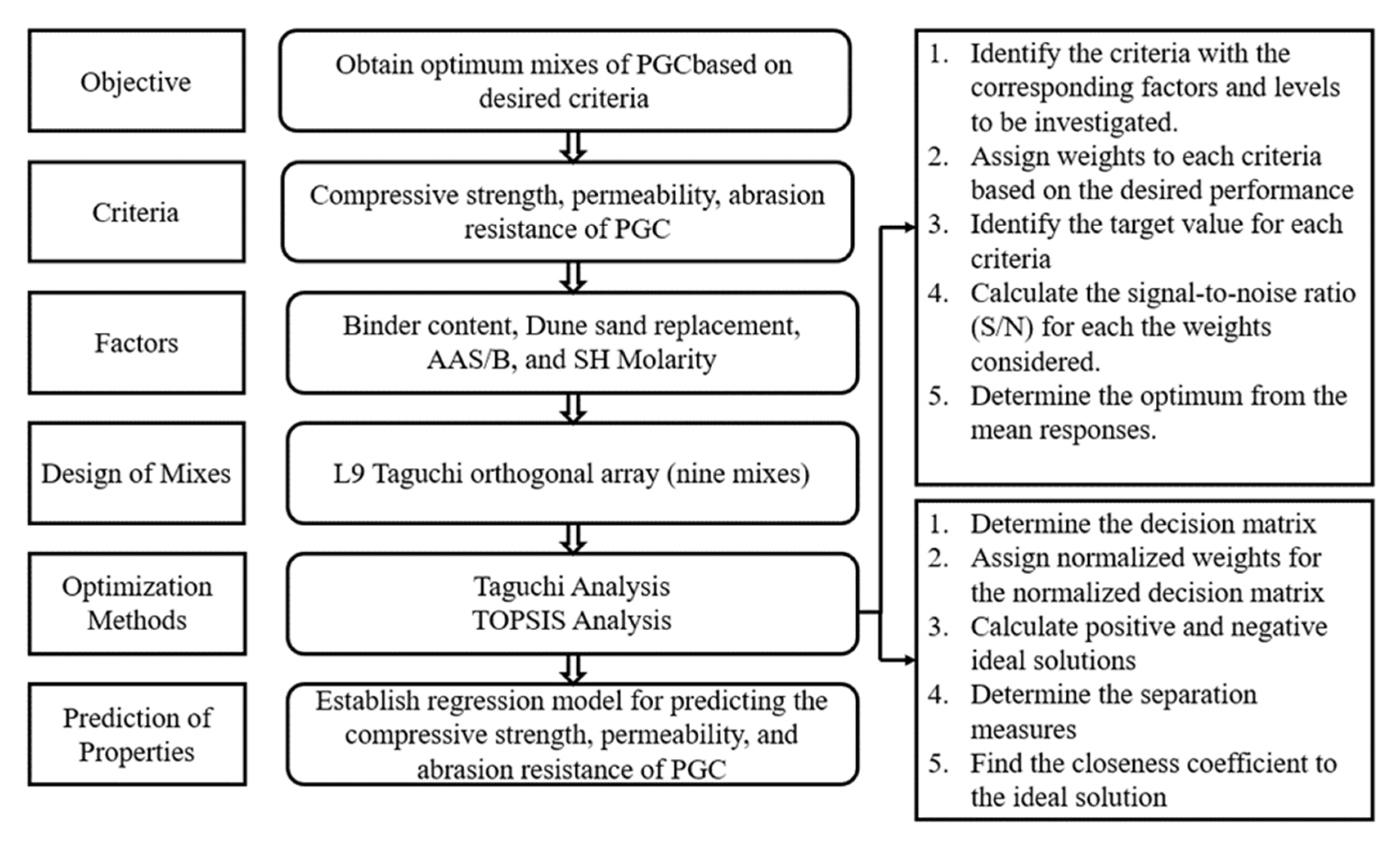
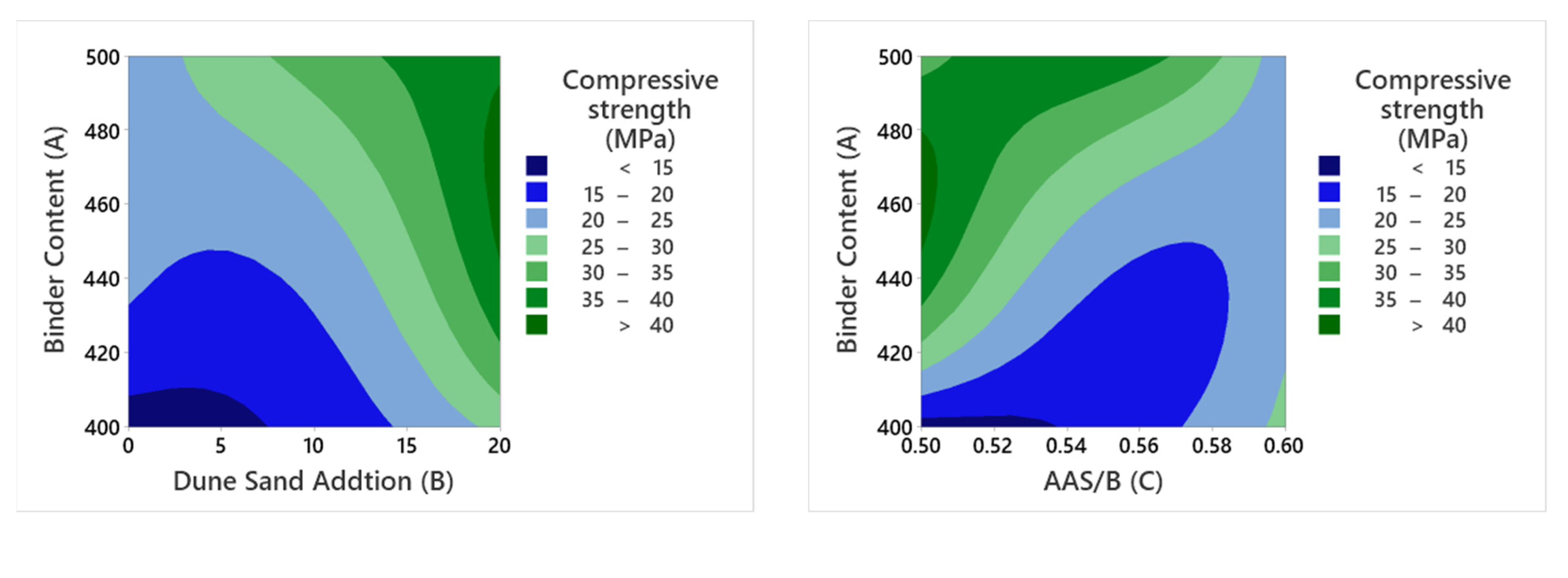
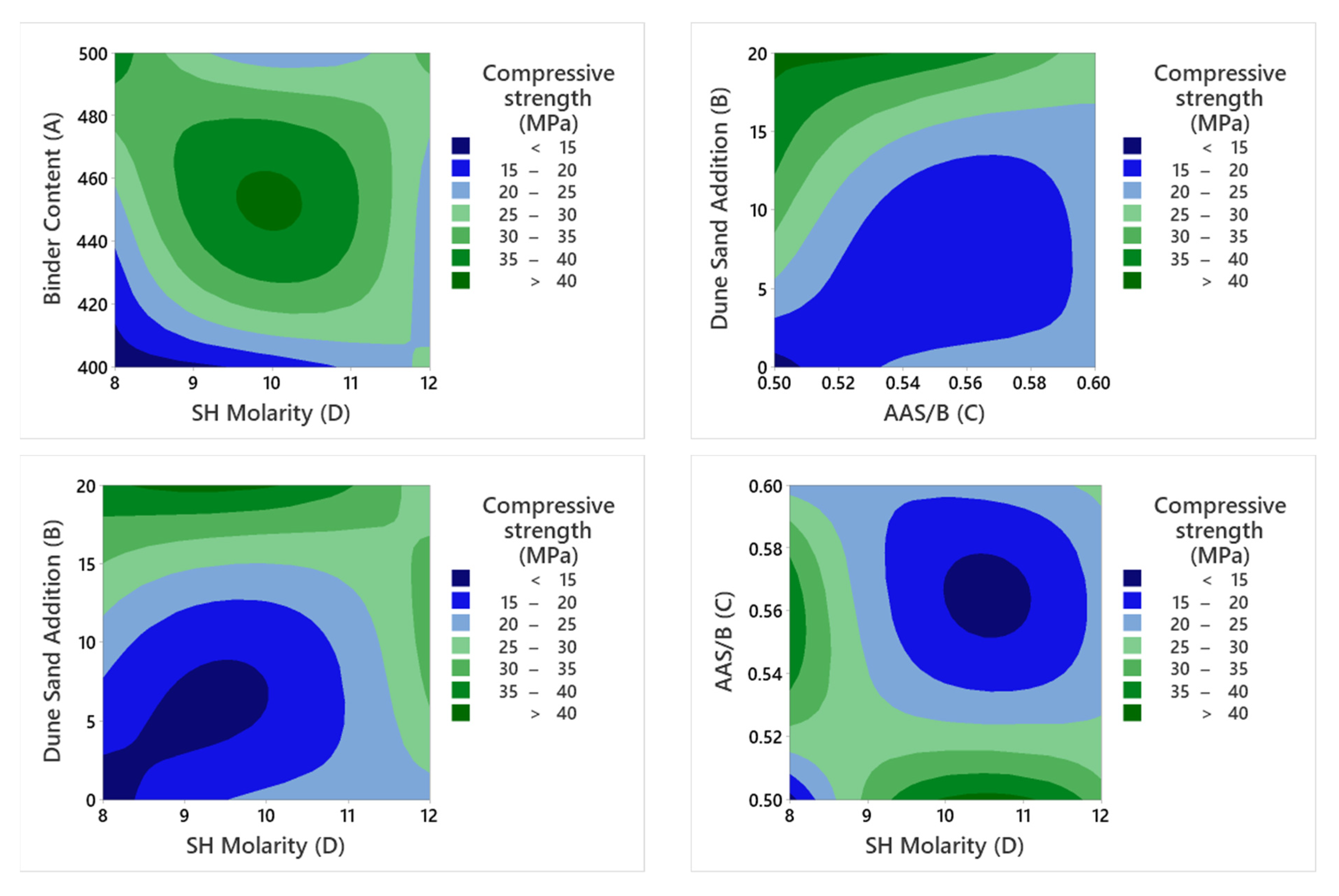
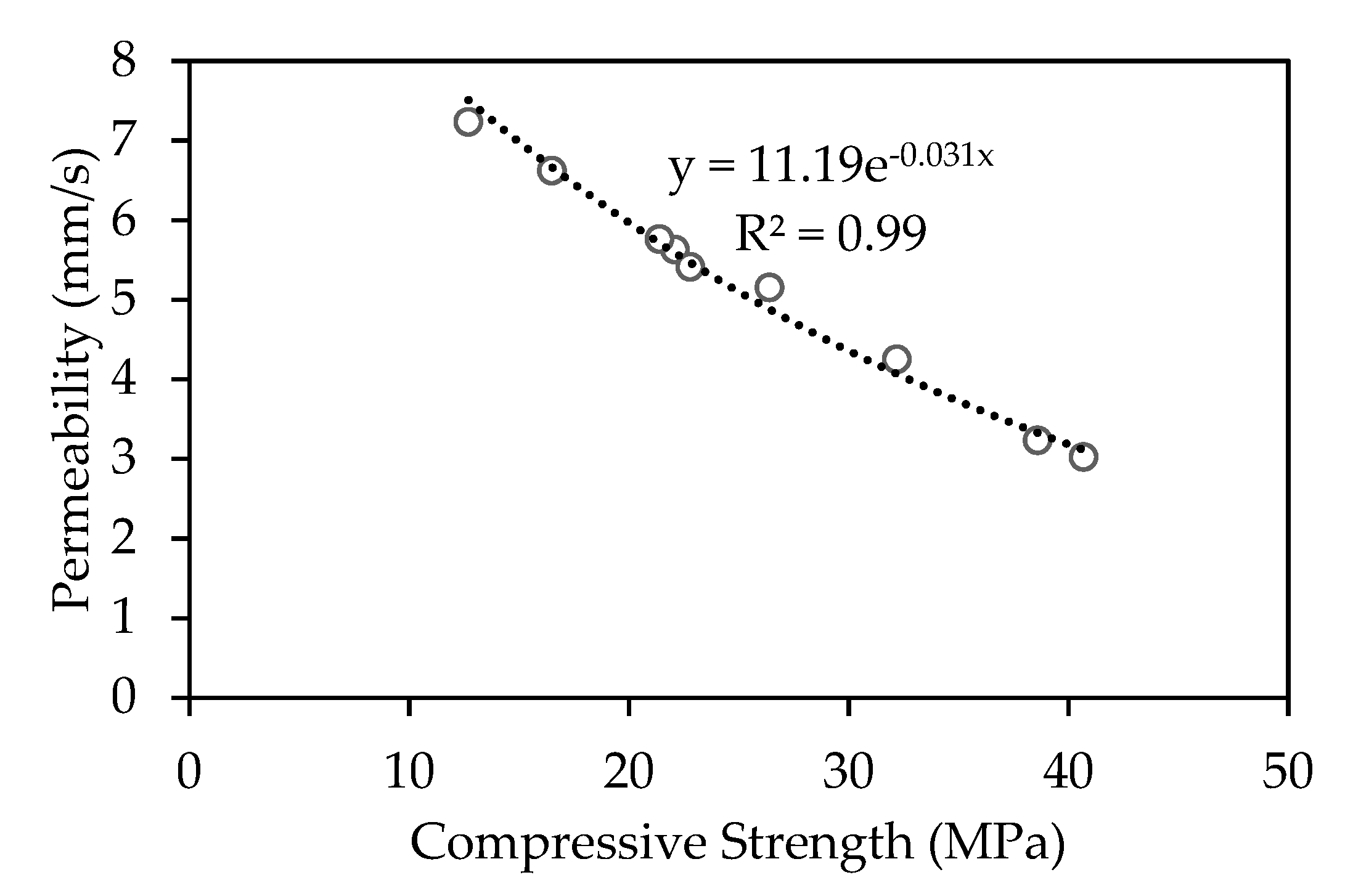

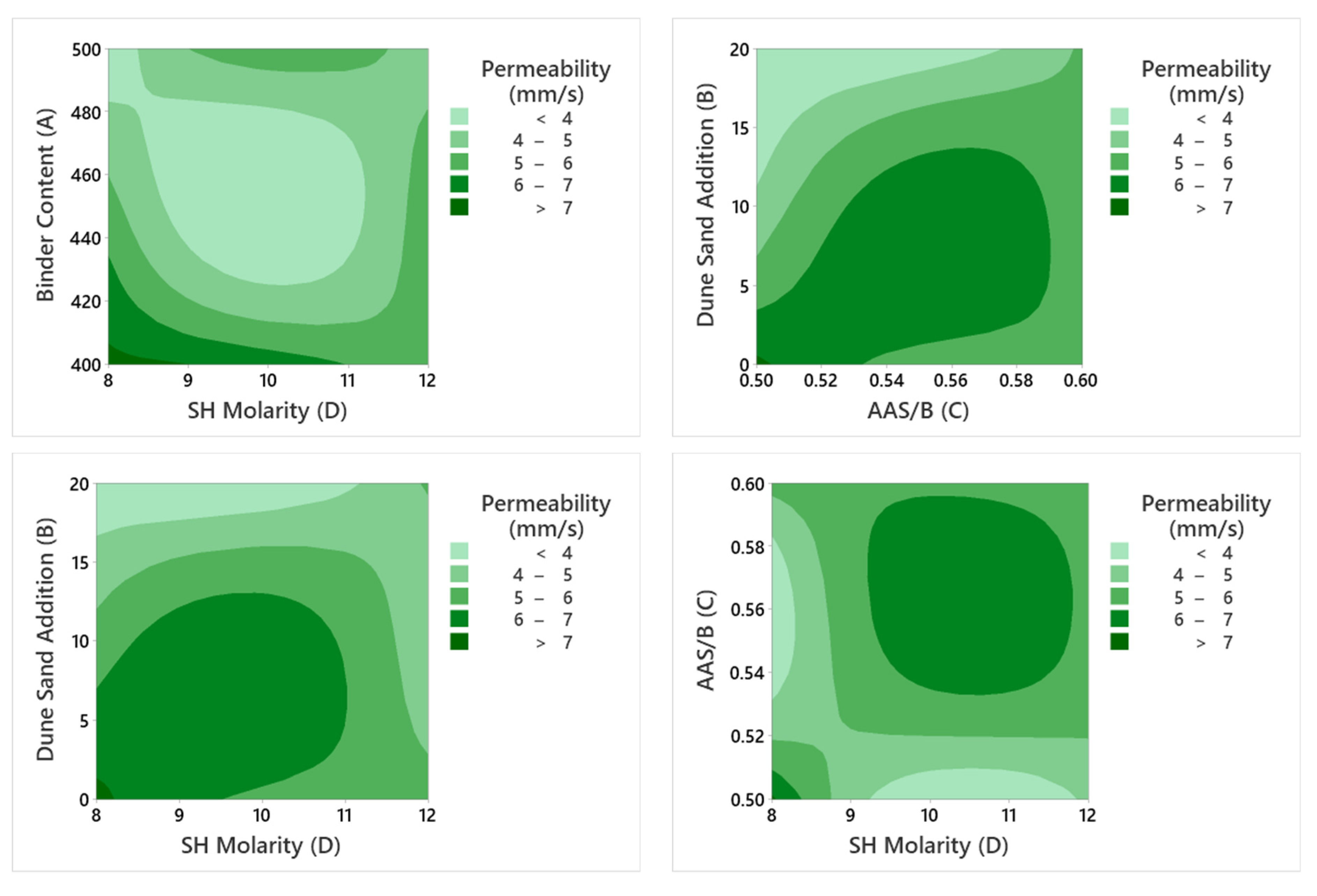
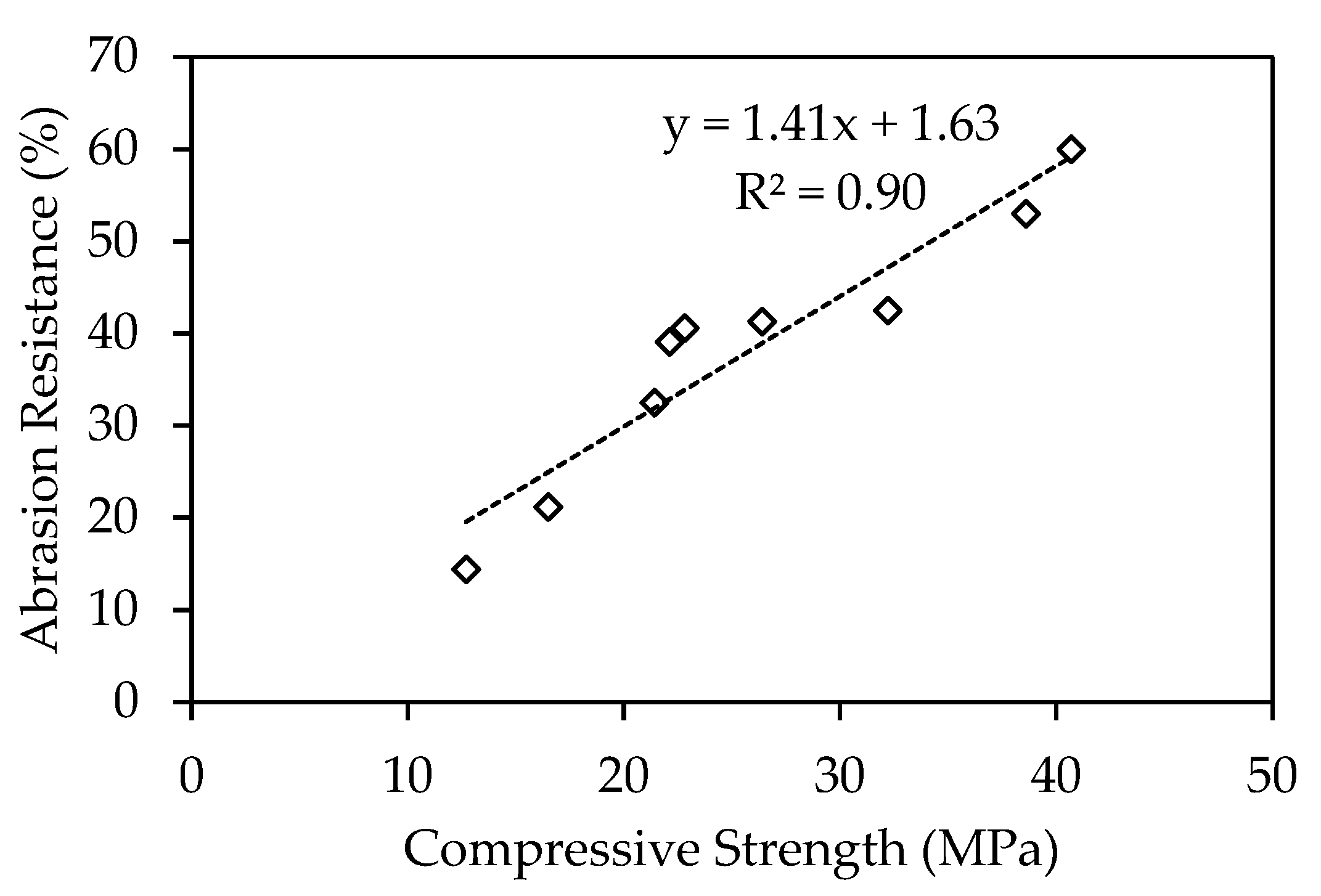

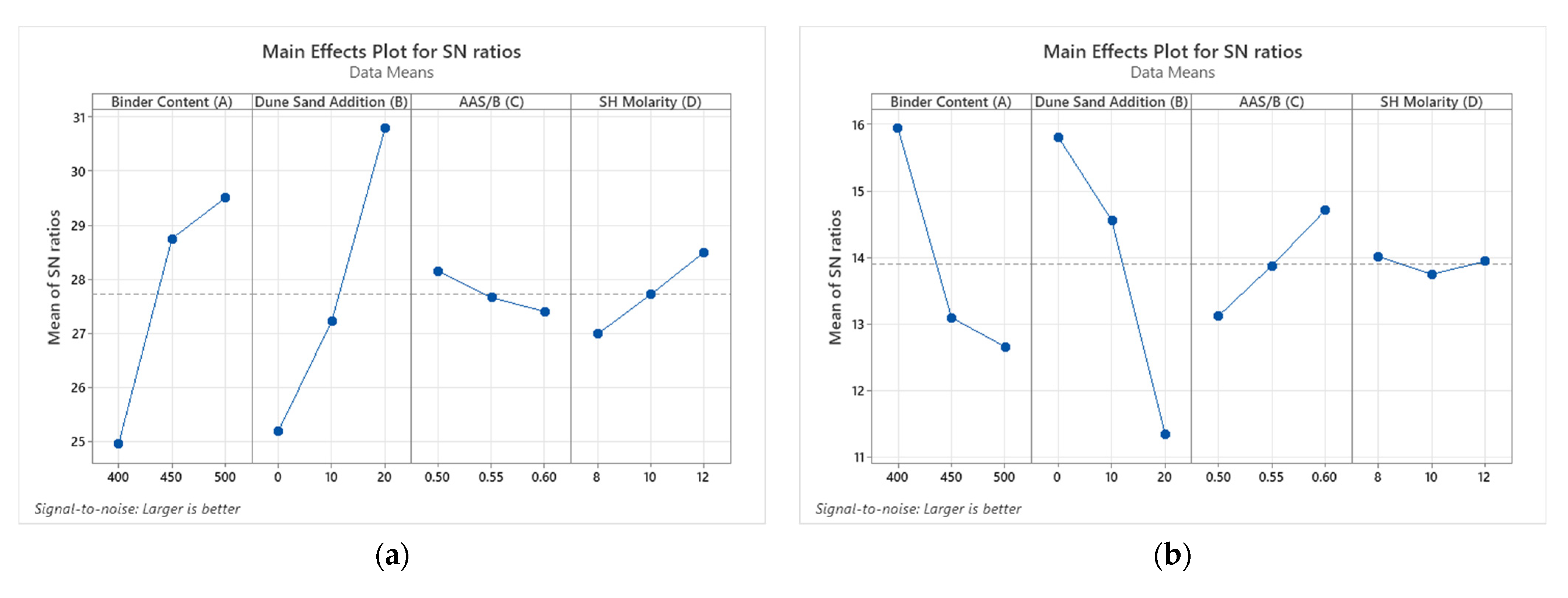
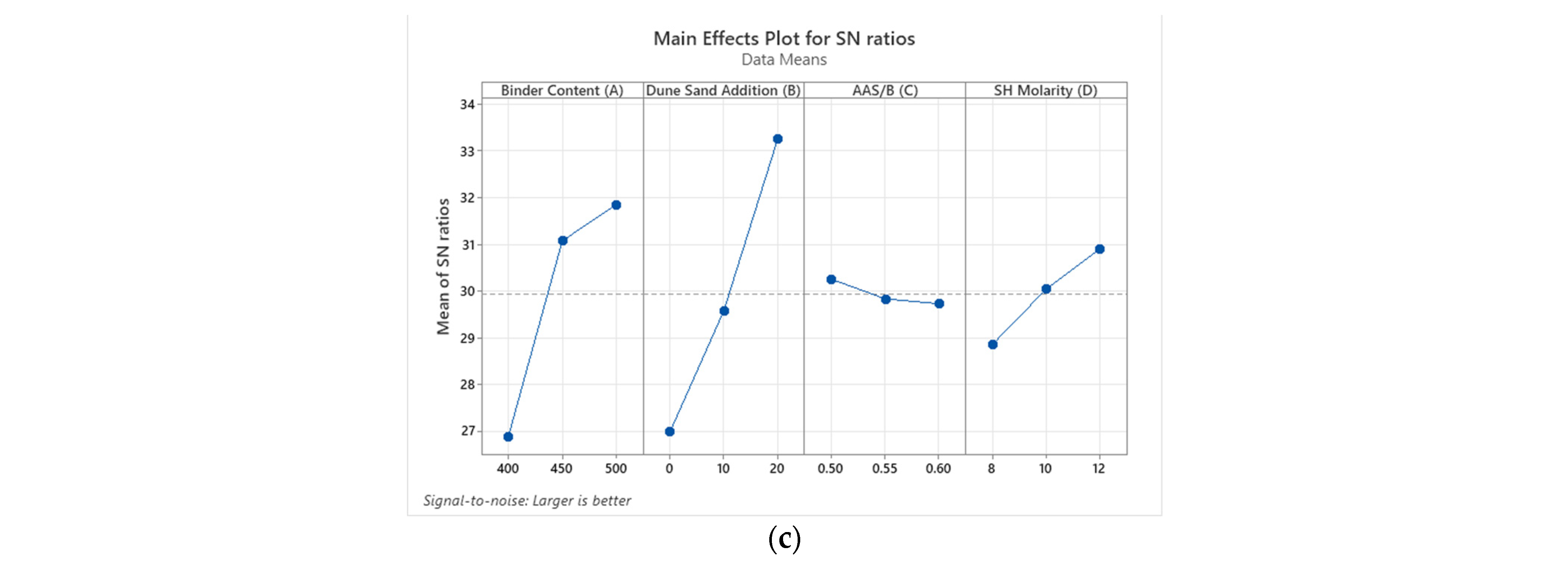


| Component, Unit | FA | GBFS | Dune Sand |
|---|---|---|---|
| SiO2, (wt.%) | 48.0 | 27.8 | 64.9 |
| CaO, (wt.%) | 3.3 | 58.6 | 14.1 |
| Al2O3, (wt.%) | 23.1 | 8.1 | 3.0 |
| Fe2O3, (wt.%) | 12.5 | 1.3 | 0.7 |
| MgO, (wt.%) | 1.5 | 6.0 | 1.3 |
| Na2O, (wt.%) | 0.0 | 0.2 | 0.4 |
| Others, (wt.%) | 10.5 | 0.3 | 15.5 |
| LOI, (wt.%) | 1.1 | 0.9 | 0.0 |
| Specific gravity | 2.32 | 2.70 | 2.77 |
| Unit weight, kg/m3 | 1262 | 1209 | 1660 |
| Factor | Level 1 | Level 2 | Level 3 |
|---|---|---|---|
| Binder content (kg/m3) | 400 | 450 | 500 |
| Dune sand addition (wt.%) | 0 | 10 | 20 |
| AAS/B ratio | 0.50 | 0.55 | 0.60 |
| SH Molarity (M) | 8 | 10 | 12 |
| Mix No. | Binder Content (kg/m3) | Dune Sand Addition (wt.%) | AAS/B Ratio | SH Molarity (M) |
|---|---|---|---|---|
| 1 | 400 | 0 | 0.50 | 8 |
| 2 | 400 | 10 | 0.55 | 10 |
| 3 | 400 | 20 | 0.60 | 12 |
| 4 | 450 | 0 | 0.55 | 12 |
| 5 | 450 | 10 | 0.60 | 8 |
| 6 | 450 | 20 | 0.50 | 10 |
| 7 | 500 | 0 | 0.60 | 10 |
| 8 | 500 | 10 | 0.50 | 12 |
| 9 | 500 | 20 | 0.55 | 8 |
| Mix No. | Binder Content (kg/m3) | Dune Sand Addition (wt.%) | AAS/B Ratio | SH Molarity (M) | Compressive Strength (MPa) | Permeability (mm/s) | Abrasion Resistance (%) |
|---|---|---|---|---|---|---|---|
| 1 | 400 | 0 | 0.50 | 8 | 12.7 | 7.23 | 14.4 |
| 2 | 400 | 10 | 0.55 | 10 | 16.5 | 6.62 | 21.2 |
| 3 | 400 | 20 | 0.60 | 12 | 26.4 | 5.15 | 35.3 |
| 4 | 450 | 0 | 0.55 | 12 | 22.1 | 5.63 | 28.1 |
| 5 | 450 | 10 | 0.60 | 8 | 22.8 | 5.41 | 29.6 |
| 6 | 450 | 20 | 0.50 | 10 | 40.7 | 3.02 | 55.0 |
| 7 | 500 | 0 | 0.60 | 10 | 21.4 | 5.76 | 27.5 |
| 8 | 500 | 10 | 0.50 | 12 | 32.2 | 4.25 | 43.5 |
| 9 | 500 | 20 | 0.55 | 8 | 38.6 | 3.23 | 50.0 |
| Response Criterion | Normalized Weights for Each Criterion | ||||
|---|---|---|---|---|---|
| Target Values | Scenario 1 | Scenario 2 | Scenario 3 | Scenario 4 | |
| Compressive Strength | Larger is better | 0.80 | 0.10 | 0.10 | 0.33 |
| Permeability | Larger is better | 0.10 | 0.80 | 0.10 | 0.33 |
| AbrasionResistance | Larger is better | 0.10 | 0.10 | 0.80 | 0.33 |
| Mix No. | S/N 1 (Compressive Strength) | S/N 2 (Permeability) | S/N 3 (Abrasion Resistance) |
|---|---|---|---|
| 1 | 22.08 | 17.18 | 23.17 |
| 2 | 24.35 | 16.42 | 26.53 |
| 3 | 28.43 | 14.24 | 30.96 |
| 4 | 26.89 | 15.01 | 28.97 |
| 5 | 27.16 | 14.66 | 29.43 |
| 6 | 32.19 | 9.60 | 34.81 |
| 7 | 26.61 | 15.21 | 28.79 |
| 8 | 30.16 | 12.57 | 32.77 |
| 9 | 31.73 | 10.18 | 33.98 |
| Mix No. | Scenario 1 | Scenario 2 | Scenario 3 | Scenario 4 |
|---|---|---|---|---|
| 1 | 0.1552 | 0.8903 | 0.1472 | 0.5035 |
| 2 | 0.2654 | 0.8690 | 0.3147 | 0.5589 |
| 3 | 0.6282 | 0.6127 | 0.6670 | 0.6305 |
| 4 | 0.4840 | 0.7096 | 0.5042 | 0.5971 |
| 5 | 0.5084 | 0.6651 | 0.5410 | 0.5933 |
| 6 | 0.8448 | 0.1097 | 0.8528 | 0.4965 |
| 7 | 0.4586 | 0.7347 | 0.4899 | 0.5976 |
| 8 | 0.7778 | 0.3992 | 0.8017 | 0.5839 |
| 9 | 0.8444 | 0.1308 | 0.8419 | 0.5015 |
| Compressive Strength | Permeability | Abrasion Resistance | |
|---|---|---|---|
| α0(A) | 1.122 | −0.179 | 1.687 |
| α1(B) | 0.194 | −0.035 | 0.447 |
| α2(C) | −921.000 | 176.000 | −1457.000 |
| α3(D) | 0.800 | 0.220 | 4.400 |
| α4(A2) | −0.001 | 0.001 | −0.002 |
| α5(B2) | 0.032 | −0.004 | 0.036 |
| α6(C2) | 791.000 | −154.000 | 1261.000 |
| α7(D2) | −0.015 | −0.014 | −0.168 |
| R2 | 0.99 | 0.98 | 0.99 |
| RMSE | 1.04 | 0.37 | 1.20 |
Publisher’s Note: MDPI stays neutral with regard to jurisdictional claims in published maps and institutional affiliations. |
© 2022 by the authors. Licensee MDPI, Basel, Switzerland. This article is an open access article distributed under the terms and conditions of the Creative Commons Attribution (CC BY) license (https://creativecommons.org/licenses/by/4.0/).
Share and Cite
Anwar, F.H.; El-Hassan, H.; Hamouda, M.; El-Mir, A.; Mohammed, S.; Mo, K.H. Optimization of Pervious Geopolymer Concrete Using TOPSIS-Based Taguchi Method. Sustainability 2022, 14, 8767. https://doi.org/10.3390/su14148767
Anwar FH, El-Hassan H, Hamouda M, El-Mir A, Mohammed S, Mo KH. Optimization of Pervious Geopolymer Concrete Using TOPSIS-Based Taguchi Method. Sustainability. 2022; 14(14):8767. https://doi.org/10.3390/su14148767
Chicago/Turabian StyleAnwar, Faiz Habib, Hilal El-Hassan, Mohamed Hamouda, Abdulkader El-Mir, Safa Mohammed, and Kim Hung Mo. 2022. "Optimization of Pervious Geopolymer Concrete Using TOPSIS-Based Taguchi Method" Sustainability 14, no. 14: 8767. https://doi.org/10.3390/su14148767
APA StyleAnwar, F. H., El-Hassan, H., Hamouda, M., El-Mir, A., Mohammed, S., & Mo, K. H. (2022). Optimization of Pervious Geopolymer Concrete Using TOPSIS-Based Taguchi Method. Sustainability, 14(14), 8767. https://doi.org/10.3390/su14148767








